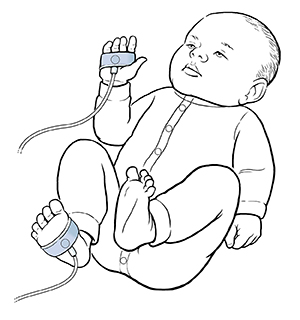Your Child's Screening for Congenital Heart Defects with Pulse Oximetry
Pulse oximetry is a quick, simple, and painless test. It can be used to screen for certain heart defects that a baby can be born with.
During the test, a sensor is put on your baby's hand and foot. The sensors are connected to a small device that measures the amount of oxygen in your baby's blood. This test can't screen for all heart defects. But it may be able to find several types known as critical congenital heart defects. Some of these are:
-
Hypoplastic left heart syndrome (HLHS)
-
Transposition of the great arteries (TGA)
-
Tricuspid atresia (TA)
-
Total anomalous venous return (TAPVR)
-
Tetralogy of Fallot (TOF)
-
Truncus arteriosus
-
Pulmonary atresia with intact ventricular septum
-
Coarctation of the aorta
Before the procedure
The results are most accurate when a baby is awake, warm, and quiet. Movement and crying can affect the accuracy of the test. Your baby may be wrapped in swaddling clothes to keep warm. You may be asked to hold your baby to help keep them calm.
Remove any socks or mittens your baby is wearing. A healthcare provider may then clean and dry your baby's skin.
During the procedure
The healthcare provider will attach a small sensor to your baby's hand and foot. This is usually a flexible, sticky strip placed on the skin. In some cases, two sensors are used. One is placed on the right hand and the other is placed on the right foot. Comparing the results from the hand and foot is an important part of the test. The sensor or sensors are connected to a wire that leads to a small device. The device measures the amount of oxygen in your baby's blood.

After the procedure
The healthcare provider will remove the sensor or sensors. Any sticky adhesive left on the skin will be cleaned off.
If the reading is below a certain number, your baby may need more tests. They may also need more tests if there is a significant difference between the hand and foot results. These additional tests may include an ultrasound of the heart (echocardiogram). They may also need to be seen by a cardiac specialist.
It's important to remember that this test won't find all heart defects. Sometimes, it may not find one of the defects it's intended to find. Because of this, your baby will also have a comprehensive history and physical exam. In addition, always make sure you keep all your baby's appointments with the healthcare provider.